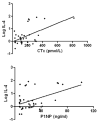Plasma inflammatory mediators associated with bone metabolism in COPD
- PMID: 20486817
- PMCID: PMC3985167
- DOI: 10.3109/15412555.2010.482114
Plasma inflammatory mediators associated with bone metabolism in COPD
Abstract
ABSTRACT The association of osteoporosis with COPD is well established, but the relationship between systemic inflammatory mediators and bone metabolism has not been explored. Plasma samples from 40 COPD patients awaiting lung transplantation were analyzed for 27 inflammatory mediators using a multiplex protein array. C-telopeptide type I collagen (CTx), a marker of bone resorption, was measured with ELISA, and N-terminal procollagen propeptide (P1NP), a marker of bone formation, was ascertained with a radioimmunoassay. Associations between inflammatory mediators versus CTx and P1NP with adjustments for steroid and bisphosphonate use were determined. Mean age was 59 years (+/- 6) and FEV(1) was 23.5% (+/- 8.3%) predicted. Ninety-five percent of the subjects had low bone mineral density measured by dual x-ray absorptiometry (DXA). Tumor necrosis factor alpha and interleukin 4 were positively associated with CTx and P1NP. RANTES and eotaxin were inversely associated with CTx and P1NP. Interleukin 2 and interferon gamma were also directly associated with P1NP. Biologically plausible systemic mediators are associated with bone metabolism in patients with severe COPD, offering potential insight into risk factors and underlying mechanisms of bone disease. Furthermore, they may be useful in monitoring disease activity, and serve as targets for biological therapy.
Figures



References
-
- Agusti AGN. Systemic effects of chronic obstructive pulmonary disease. Proceedings of the American Thoracic Society. 2005;2:367–370. - PubMed
-
- Decramer M, Rennard S, Troosters T, Mapel DW, Giardino N, Mannino D, Wouters E, Sethi S, Cooper CB. Copd as a lung disease with systemic consequences--clinical impact, mechanisms, and potential for early intervention. COPD. 2008;5:235–256. - PubMed
-
- Ionescu AA, Schoon E. Osteoporosis in chronic obstructive pulmonary disease. Eur Respir J. 2003;22:64S–75. - PubMed
-
- Sin DD, Man JP, Man SF. The risk of osteoporosis in caucasian men and women with obstructive airways disease. Am J Med. 2003;114:10–14. - PubMed
Publication types
MeSH terms
Substances
Grants and funding
LinkOut - more resources
Full Text Sources
Medical
